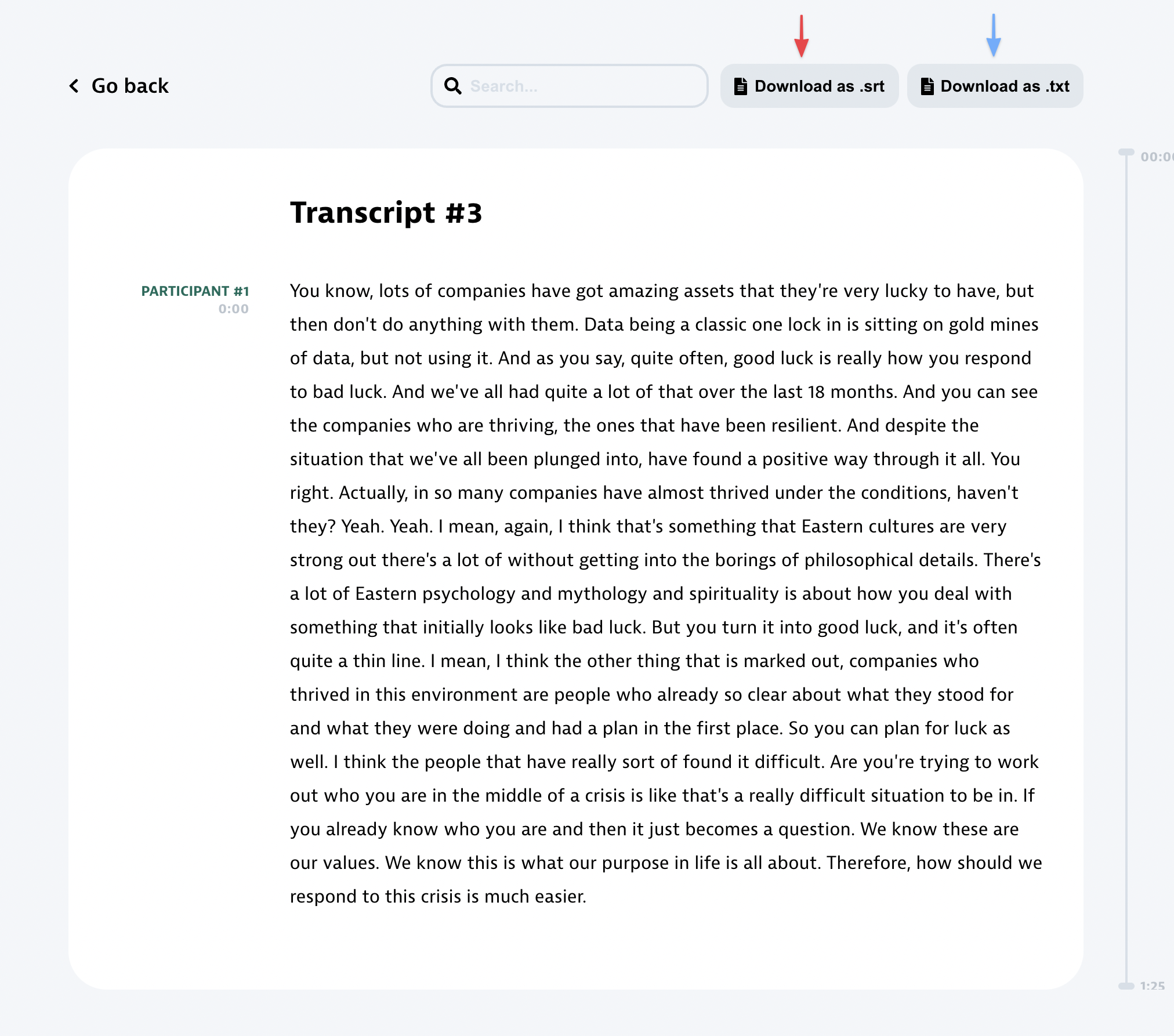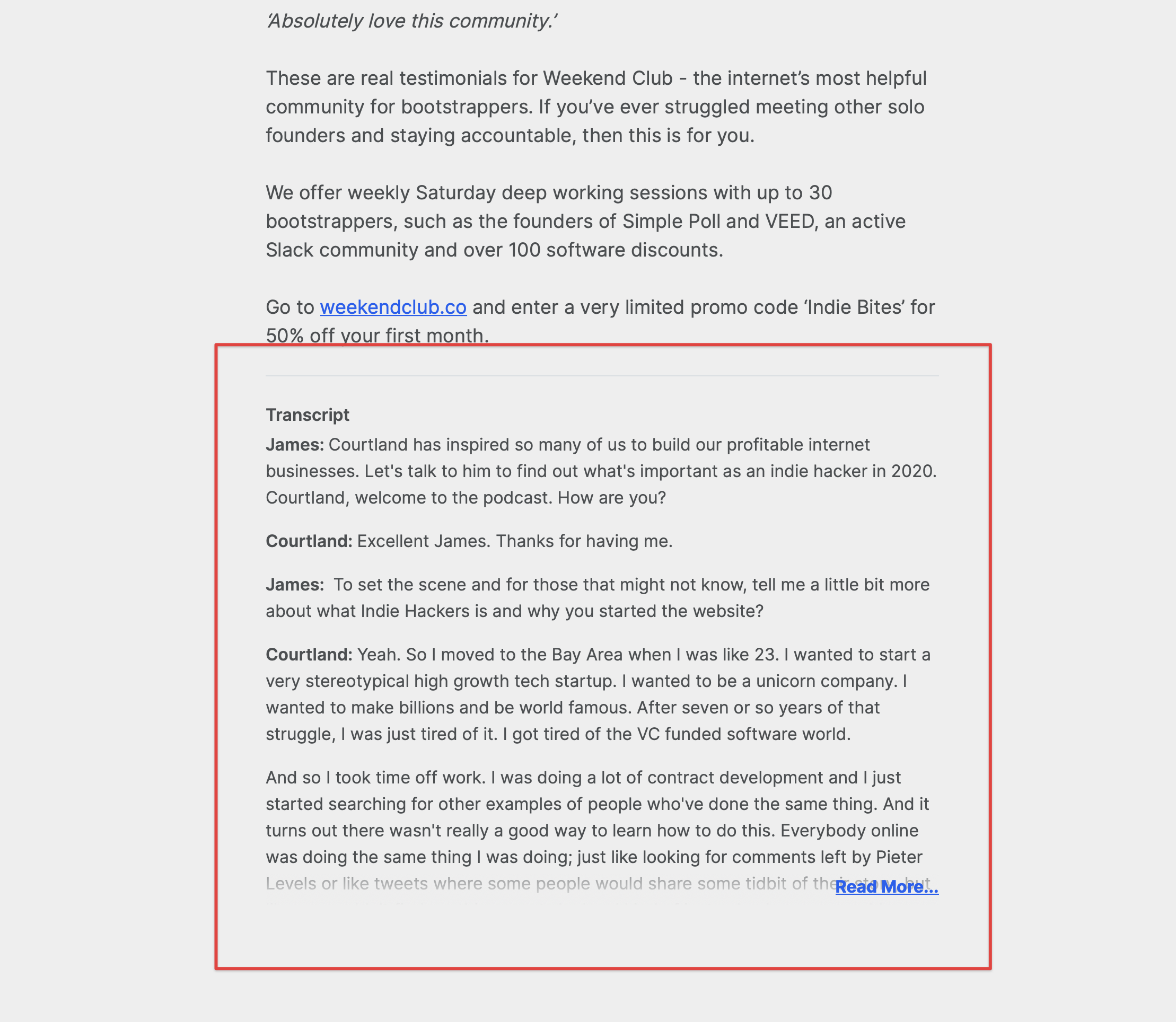
How to Create a Transcript
A word-for-word podcast transcript will make your show more discoverable, more accessible and help you produce additional content to grow your show. In this article we'll show you how you can make your own podcast transcript for free, with no additional effort.

Before, this was a case of listening back to your recording and writing each word out, which could take hours. Alternatively, you could try less-than-accurate cheap online services, such as Rev, that you'd end up spending an equal amount of time correcting.
When you record a podcast using Welder, we'll automatically generate a transcript for you that will be available to use directly after the recording, ready for you to publish straight away or download to edit.
What is a podcast transcript?
A podcast transcript is a word-for-word text version of your show that is published to your website as a searchable, indexable and accessible piece of content. Some podcasters overlook the transcript without realising how easy it is to do any the benefits it can have for your show.
The benefits of a transcript
Having a transcript for your show will give you 4 main benefits, all of which can have a unique impact on your show.
Accessibility
Making your show more accessible for the millions of people that are deaf or hard-of-hearing will help your show be inclusive and open you up to potential new listeners. You'll be appealing to a wide scope of people from those who struggle to understand words or accents, to those that can't listen to any of your show.
SEO
Having a written transcript means your audio show will now be indexable by Google, meaning if throughout your episode (30 mins ≠ 6,000 words) you have mentioned products, asked questions or referenced resources, they will all be searchable with Google. If ever you wanted an easy way to boost your podcast's presence then a transcription is a sure-fire way to do so.
Referencing
Being able to search through your own recording to reference things, or for your listeners to be able to do the same thing. You might have mentioned a book or podcast you want to listen to later, or you might want to find a particular quote that resonated with you or a listener. Without a transcript you'd have to potentially listen back through the entire episode to find what you're looking for. With a transcript, you can find it in no time at all.
Content
The search-ability of a transcript also makes it incredibly easy for you to make extra content about your show, which could be supplementary for listeners or for growing your audience. This could be in the form of social media posts with quotes, a written blog summary of the episode or shorter video quotes made with VEED (which you can find much more quickly).
How to make a transcript
Manual Transcript
The most manual and time intensive way to generate a podcast transcript is to write it yourself in a word processor. This is a case of listening back to your show and painstakingly typing up every word that is said, also tagging the names of the speakers throughout. This can sometimes take hours after the recording when that time could be better off spent elsewhere!
- Play your podcast file
- Open up a word processor and start typing (format as you go)
Pro tip: if you'd like to type without regularly pausing the audio, play it back at 0.5x speed.
Welder
The easiest way to get a transcript is use Welder (but we are a little biased). You can either get your transcript directly after your recording using Welder - which has the added benefit of adding markers throughout - or you can upload your file recorded elsewhere and it will generate a transcript of that audio. The best thing? It's completely free.
- Click "upload and transcribe your podcast for free"

- Create an account / login with Google (unless you already have one)
- Drag and drop your audio or video file in the box
- Click upload file
- Wait a few minutes for the transcription to be generated


- When the transcript has finished processing, it will change to a "Transcription" button, click that to view your transcript.

- You'll then be taken to the transcript page where you can download the file as a .srt file to upload to your video player, or as a .txt file to add to your website.

So now you have your podcast transcript generated for free in just a few minutes.
If you recorded your show using Welder, there is a little "Get Transcription" button you'll find next to your files.

Online service
There are other online services that allow you to upload your file and pay to receive your transcript. You might have heard of Rev, which is the most popular transcription service, that charge $1.25 per minute of audio. You could also use VEED, that will subtitle your video or audio for free with a watermark or unlimited for $20 a month.
- Upload your file to Rev.com

- Check your happy with the price, add your extras and click checkout

- Once you've paid, depending on the length of your transcription, you'll have to wait a few hours for your files to be sent back to you.
- You'll then be able to edit your transcript or download it in a variety of file formats for use later.

Where to use a transcript
Now you have your transcript, it's time to reap the rewards. Some podcasters might be wondering if they should put their transcript either on their website or in their show notes? As many podcast hosts and websites handle this differently, it depends on a few factors.
- Your podcast host
- Your show notes format
- Your website provider
If you don't have a website for your podcast, then you can add your transcript into your show notes. However, if you have a website then you may end up with content duplication which may be detrimental to your SEO.
For my show I use PodPage for my website and Transistor as my host. With PodPage, the transcript can be copy and pasted in and sits below the show notes like this:

If you are using Wordpress for your podcast website it will likely be a custom field that you add for your transcript, so will be different on a case by case basis.
When I upload my transcript to Transistor, they will be automatically added to my Transistor share page (which is separate to my website), my RSS feed and also uses the the new podcast:transcript tag (from Podcast Index) to link to a transcript (TXT) or a captions file (SRT or VTT).
Examples of transcripts in the wild
Surprisingly, there are still quite a few large podcasts that still don't have podcast transcripts available. I spoke with my little sister who was hard of hearing and she didn't even realise transcripts were a thing! And when I asked her the podcasts she listened to regularly, I couldn't find transcripts on any of the shows - which is a shame. So we all need to do better and get transcripts on each of our episodes to make them more accessible.
So take a few of these podcasts that include a transcript as inspiration:
- Indie Hackers Podcast
- The Tim Ferriss Show
- This American Life
- Freakonomics
- Masters of Scale [downloadable]
Do you need a podcast transcript?
So do you really need a transcript? If you want to make your show accessible to all, reap the SEO benefits and use the ability to reference your show in promotional content, then yes. Especially when you can do it completely free with Welder, it's a no brainer.
Recap
- Podcast transcripts will benefit your show in 4 key areas. SEO, accessibility, referencing and content.
- You can either do it manually yourself, use Welder's free tool or use an online service such as Rev to pay to have them manually do it for you.
- Once you have your transcript you can upload it to your website, put it in your show notes or use your podcast host to do both, but be wary of duplicate content.
- Finally, there are some amazing shows who are putting out high-quality transcripts, but we can do better to make our shows more accessible using some of the above as inspiration.
Go live, edit & repurpose your video content with a single tool.
1 live stream = 10+ extra pieces of video content